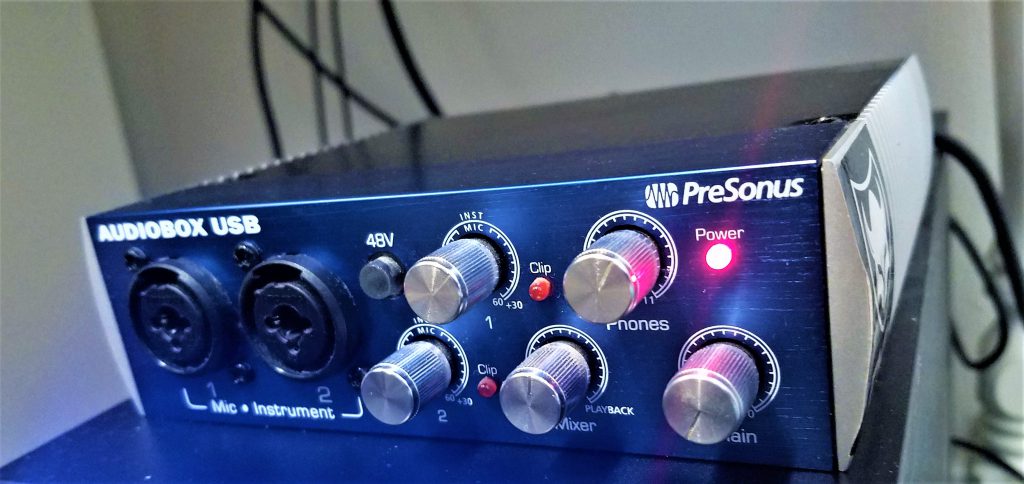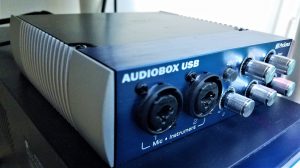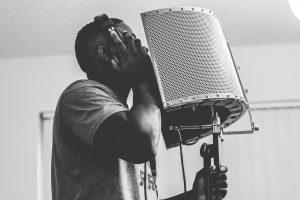
PreSonus Audiobox USB Review – Fresh Look
Welcome! If you have any interest in upgrading your listening experience to something more versatile and high powered, you’ve come to the right place. This time we’ll be taking a look at the Presonus Audiobox USB, which is a USB audio interface recording system.
You do not have to be into home/studio recording to be able to utilize this device. If all you’re looking for is a new way to listen to your favorites, you can hook one of these up to your studio monitors and you’ll be well on your way to maximum enjoyment.

Presonus Audiobox USB Review – A Fresh Look!
Here are the basic features and functions of this recording device that we’ll be covering here:
- Music Recording and Production
- Converting Digital Signals Into Analog
- Elevate Your Listening/Recording Experience
- Ability To Record on the Go As Needed
If you’re ready to get started, let’s take a look at the music recording and production aspect!
Music Recording and Production
For those of you that are not interested in recording guitars, vocals, or recording in general, you can probably skip ahead to the next section. For those of you who ARE interested in the music recording/production area let’s dive right in.
When I purchased the Presonus Audiobox it made sense for a couple reasons. For one, it came with a DAW called Studio One Artist. For someone like me who was a complete newbie, I was instructed on why this would be smart. Without the DAW (digital audio workstation) I would be unable to actually use the Audiobox for recording. Plus, getting free items/software with a purchase you were going to make anyways is never a bad thing.

Unless you have enough money to build a recording studio from the ground up, this is an awesome deal to get started on manifesting your ideas and being able to save them in hi-res audio files such as WAV, FLAC, or MP3s.
Studio One
Studio One Artist is included with your purchase of the Audiobox as I mentioned above. This particular DAW is pretty straightforward to learn how to use. After watching a couple of YouTube videos and spending time messing around with the program, you’ll start to feel like an expert soon enough. Like anything that’s worth doing, it might not be as easy as tying your shoes but well worth it nonetheless.
Without getting too deep into giving a Studio One tutorial, just know that when you want to make some music, it’ll be there at your fingertips waiting to be of service.
Converting Digital to Analog
A few people have asked me in the comment section about DACs and which one I use if any. The digital to analog converter I use is the Presonus Audiobox. There are other options available for this purpose but since I like to kill at least two birds with one stone, this works for me.
If you ever plan on using studio monitors to consume your audio content you will need some sort of audio interface to be able to convert the signal being sent from your computer through the audio interface and into your monitors.
This can be seen in the picture below:

USB Connection=Convenience At It’s Finest
This brings us to another feature of the audio interface that makes things super convenient for all of us. The USB connection is a godsend because it allows us to plug our Audiobox into our laptop or desktop. Let’s say you take a trip to Italy and want to be able to get your idea down while you’re at your hotel room.
What’s the solution? Pack this little device in your bags, bring your laptop, plug it in, record your idea. Simplicity is a beautiful thing sometimes. You don’t need a ton of room in your suitcase, and you won’t have to pack an entire bag just for the chords.

The Audiobox only uses the USB connection chord and then a microphone cable that you plug your mic or instrument into. That’s two chords, maybe 3 max depending on what you hope to accomplish.
Thinking back on it now, I wish I would’ve utilized these features on some of the travels I’ve taken in the past. There’s nothing worse than feeling a surge of inspiration and not being able to put it down right then and there. By the time you get back to your setup, the idea’s completely gone.
Elevate Your Listening/Recording Experience
Since we covered the travel-ready aspects of this device, now we can move on to using it at home or in the studio.

If you’re surprised by the quality of the recording you’re able to get with this audio interface I don’t blame you. For such a low price it blew me away too.
Microphone Cables – For Recording Instruments
Since you’ll need at least one microphone cable for recording, here’s a link to one available for free shipping through Amazon:
6ft. Microphone XLR Cable:
There are a couple of options available and I think the length of the chord should determine your choice. I would personally recommend a 6 ft. or longer cable.
10 ft. Microphone XLR Cable:
Now you’ll be ready to start recording, as long as you have a microphone that’s compatible with the XLR cables. You could use a USB mic but from my experience, your recording will sound a lot better with a more professional mic.
For You Dedicated Listeners
If you that want to enhance the way you listen to your music and other forms of audio I hope I didn’t lose you yet. Once again this ability speaks to the versatility of the Audiobox. All you have to do now is plug your audio interface in via the USB connection and hook it up to your studio monitors. More information on studio monitors and how to do that can be found here.
In Conclusion – Why Is It Worth It?
If you made it to the end of this review, you can probably answer this question yourself. We’ll go over it one more time just in case. The Presonus Audiobox USB gives you options, comes at a low price (eligible for Prime Benefits), and can travel with you or stay at home or in studio.
You’ll be able to produce beats, record guitar riffs, piano pieces, vocal melodies, or just use it for enhanced listening. The Audiobox I have is the same one I originally purchased a couple of years ago. I still haven’t had any problems with it whatsoever. PreSonus makes durable, quality products offered at an affordable rate.
Now that you’ve read our Presonus Audiobox USB Review, what do you think? Does it have all the features you need to start recording?
If anything discussed above is among the list of what you’ve been looking for I recommend that you give this recording device a fair shake. You won’t be disappointed and I can personally testify of its usefulness and enjoyment I’ve been allowed to experience as a result of owning one.
To see more customer reviews, full technical specs, and the best price on Amazon click here.
As always, I appreciate you taking the time out of your day to read through this and I hope you found the information helpful. If you have any comments or further questions feel free to leave them below and I will be sure to respond. Thanks for stopping by to check out this review!
Sonic Elevation: Ride The Waves.
- PreSonus Audiobox USB Review – Fresh Look - October 13, 2017
- Beats Solo 3 Wireless – Headphones Review - October 11, 2017
- Top Ten Albums of 2017 - October 9, 2017



Hi Dom,
Thank you for the review. It does sound like PreSonus AudioBox offers a good set of features at an affordable price. I have couple questions, though… First, is the Studio One software made for Mac or Windows? Do I still need music editing software such as Sonar or Pro Tools to go with it? And… are you ready for the most challenging question? 🙂 Is this device and its software accessible for the blind users? Thanks again!
~ Julia
Hi Julia,
Studio One is compatible with both Windows and Mac. You do not need any additional software in order to record, etc.
Depending on what you’re purpose is for the Audiobox you might need additional equipment but for recording, mixing, or casual listening this is all you need to get started.
Here’s a link to a forum discussing usability for blind users. Good news is it looks like the answer’s YES. 🙂
Thanks for tuning in,
Dom